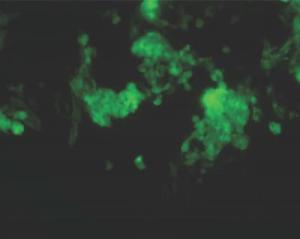There’s no shortage of therapeutic possibilities for ITD-1
For years, scientists have been looking for a good source of heart cells that can be used to study cardiac function in the lab, or perhaps even to replace diseased or damaged tissue in heart disease patients. To do this, many are looking to stem cells. Researchers at Sanford-Burnham Medical Research Institute (Sanford-Burnham), the Human BioMolecular Research Institute, and ChemRegen, Inc. have been searching for molecules that convert stem cells to heart cells for about eight years — and now they’ve found one.
Writing in the August 3 issue of Cell Stem Cell, the team describes how they sifted through a large collection of drug-like chemicals and uncovered ITD-1, a molecule that can be used to generate unlimited numbers of new heart cells from stem cells.
“Heart disease is the leading cause of death in this country. Because we can’t replace lost cardiac muscle, the condition irreversibly leads to a decline in heart function and ultimately death. The only way to effectively replace lost heart muscle cells — called cardiomyocytes — is to transplant the entire heart,” said Mark Mercola, Ph.D., director of Sanford-Burnham’s Muscle Development and Regeneration Program and senior author of the study. “Using a drug to create new heart muscle from stem cells would be far more appealing than heart transplantation.”
Searching for a needle in a haystack
Stem cells are important because they do two unique things —
- self-renew, producing more stem cells and
- differentiate, becoming other, more specialized cell types.
To obtain a large number of a certain cell type, such as heart cells, the hard part is figuring out the signals that direct them to become the desired cell type.
Mercola’s group has been hunting for heart-inducing signals for 15 years — in embryos and in stem cells. To find a synthetic molecule that might one day lead to a drug therapy to regenerate the heart, they joined forces with a team of medicinal chemists at the Human BioMolecular Research Institute led by John Cashman, Ph.D. With funding from the California Institute for Regenerative Medicine, they used sophisticated robotic technology to methodically test a large collection of drug-like chemicals, looking for that needle in a haystack that, when added to stem cells, results in cardiomyocytes. The winning compound was ITD-1.
via Science Digest
The Latest Streaming News: regenerative medicine updated minute-by-minute
Bookmark this page and come back often
Latest NEWS
Latest VIDEO








